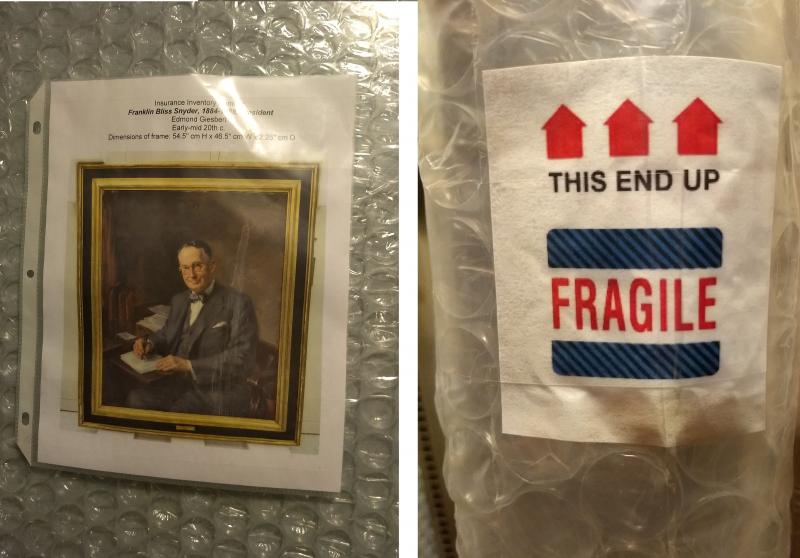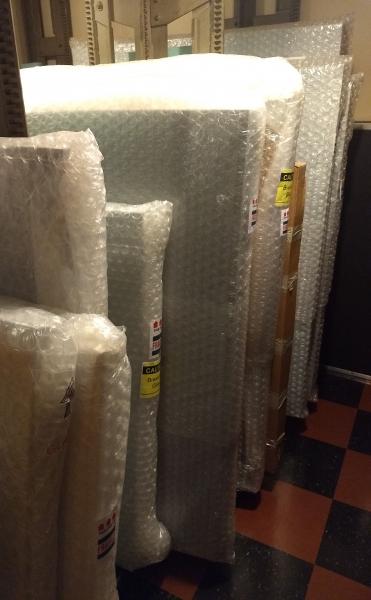Beyond the Book: Paintings
Tonia Grafakos, Marie A. Quinlan Director of Preservation, Northwestern University
Libraries are repositories for eclectic groups of materials. Paintings find their way into libraries through a variety of avenues. They can be part of a collection, a donation, or part of the institution’s history. Paintings present their own set of challenges. Some are hung in public spaces or placed in highly trafficked corridors. Others are in storage, most often in areas that were not designed for them. How can libraries be responsible stewards for this media?
Paintings have similar challenges to other library collection materials. They are prone to environmental damage due to fluctuations in temperature and humidity and can be damaged by light. Due to the highly visual nature of this art medium, the aesthetic qualities of the artwork and its physical condition are linked. There are many online resources that provide information on the composition of paintings and frames that will help staff make better-informed decisions. The resources listed at the end of this article provide detailed information on the makeup of paintings.
Like many institutions, Northwestern University strives to make the best decisions possible based on the present constraints. Those constraints can involve the buildings that objects are housed in, storage, monetary and staff resources, or other factors. The painting Matrix by Oli Sihvonen presented several different problems for the library at Northwestern. Because of the painting’s size, there are limited spaces where it can be displayed. After the painting was damaged while hanging in a student lounge, it was relocated to the main corridor of the library. However, its current location still leaves it susceptible to damage by patrons who may accidentally brush against it. Due to its location and size, a physical barrier was considered but deemed unsightly and a tripping hazard. The solution devised was to change the carpeting around the painting in order to delineate a visual safety zone. Although not perfect, the contrasting carpeting does provide a clearly defined area around the painting.

There are more conventional solutions to protecting paintings in public areas. Adding glazing can protect the surface of any painting from being damaged. This may require frames to be adjusted. Stanchions can be added to areas to provide a physical barrier. The canvas can also be protected by adding a backing board to the painting. This would protect the back of the canvas from debris and help mitigate fluctuations in temperature and humidity. The painting location, size, and condition as well as university resources will play a key role in determining what is possible.
The Preservation Department had another role to play with regards to Matrix when it became necessary to move the artwork due to a construction project. The painting’s size (7.5ft x 17ft) and location presented a unique set of challenges. Its size prevented it from being temporarily hung in another part of the building. Library staff worked closely with art handlers to have the painting removed from the wall and wrapped for temporary storage. Details about the project can be found on the Northwestern Libraries blog.
Art moving companies often provide services for packing and storing paintings. Paintings that show damage either to the frame or the canvas, those with ornate frames, or oversized paintings should all be handled with care. Conservators or art packing companies are particularly well-suited in handling these items.
Paintings on display present their own set of issues, but what does one do with paintings in the collections that are not on display? Like many other institutions, Northwestern’s paintings are scattered throughout various collections and curatorial departments. And also like many other institutions, we do not have an area specifically designed for paintings storage.
In order to tackle this problem, the Preservation Department embarked on a three-year project to inventory and wrap paintings that were in various storage locations. All paintings were identified and brief condition reports were written using a phone app. The use of the phone app allowed the staff to do both written and photographic documentation where the paintings were currently stored. Few paintings needed to be transported to the conservation lab for examination and wrapping. Additional information on electronic condition assessments using a phone app can be found on the Storage Techniques for Art, Science and History (STASH) website.
Following identification and documentation, the paintings were wrapped for safe storage. Because we do not have a dedicated painting storage area, we devised a solution that allows the paintings to be stored for an indefinite period of time and enables them to be transported safely by library personnel. It is highly likely that these paintings will need to be moved as the need for space evolves. We worked closely with a local painting conservator to understand how to pack paintings. The materials used to wrap the paintings are commonly found in libraries and included polypropylene sheeting, corrugated board, and bubble wrap. The instructions we used closely resemble those outlined by the Canadian Conservation Institute Notes 10/16.
Each wrapped painting is identified with labels on the front of the painting. Labels include a photograph of the painting, dimensions, title, artist, and date. Additional information, such as if extra care is needed or which side is the top of the painting, is added to the exterior.

When we were considering areas for potential storage sites, we looked for those that were in low use. We wanted to minimize the amount of foot traffic in the space and limit the number of book trucks or pallets that would be moving through the area. Other questions we considered were: What other items are stored in this space? Can the room be secured? Are there temperature and humidity controls in the space?

These paintings are now safely stored and can be moved as necessary. When transporting paintings, it is advisable to clear a path from where you are to where you are going, removing any obstacles in the way. Additionally, gloves should be worn when moving an unwrapped painting. The moisture and oils from your hands can cause damage to the frame.
Storage and care initiatives for your painting collections can be an imposing proposition. There are many online resources available on various care and storage issues. The Canadian Conservation Institute website offers information on different types of storage solutions to consider depending on your needs and budget. Alternatively, the American Institute for Conservation has a Find a Conservator site that can help you identify conservators in your area who can provide advice for your specific situation.
References and Additional Resources:
Caring for Your Treasures: Paintings. American Institute for Conservation.
Cleaning Paintings: Precautions. Canadian Conservation Institute. CCI Notes 10/1.
Storage and Display Guidelines for Paintings. Canadian Conservation Institute. CCI Notes 10/3.
Condition Reporting. Canadian Conservation Institute. CCI Notes 10/11.
Basic Handling of Paintings. Canadian Conservation Institute. CCI Notes 10/13
Wrapping a Painting. Canadian Conservation Institute. CCI Notes 10/16.
Know Your Paintings. Canadian Conservation Institute. CCI Notes 10/17.
Knapp, AM and West, P. Storage Screens for Paintings. National Park Service. Conserve O Gram Series. Number 12/1. July 1993.
Caring for Your Painting. Smithsonian Museum Conservation Institute.
Does My Painting Need to Be Cleaned? Smithsonian Museum Conservation Institute.
What Makes the Painting Image Change? Smithsonian Museum Conservation Institute.
What Does It Mean to Have a Painting Restored and How Do I Pick a Conservator? Smithsonian Museum Conservation Institute.
Gowler, S and Russick, S. Annotating Images with a Smartphone App. STASH. 2016.
Return to Beyond the Book: Preserving your Non-Book Collections

